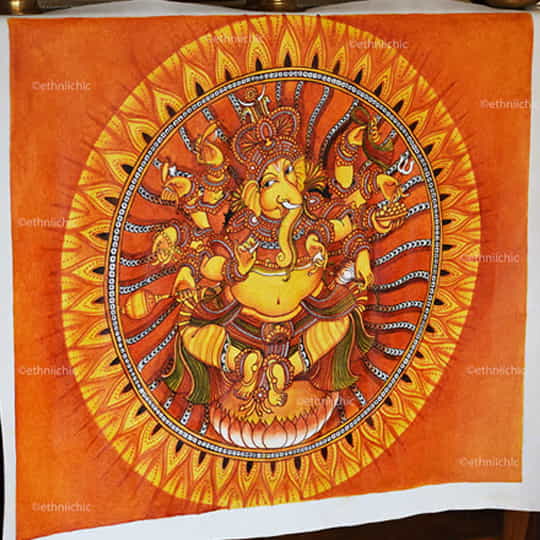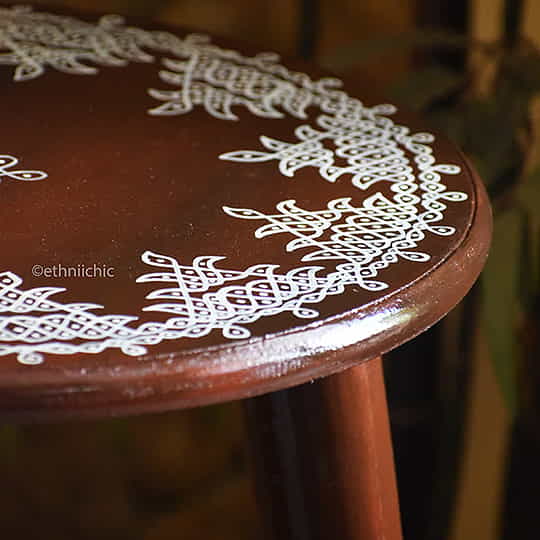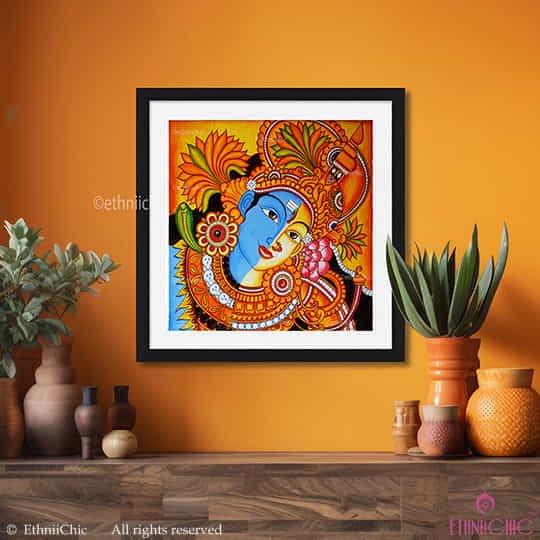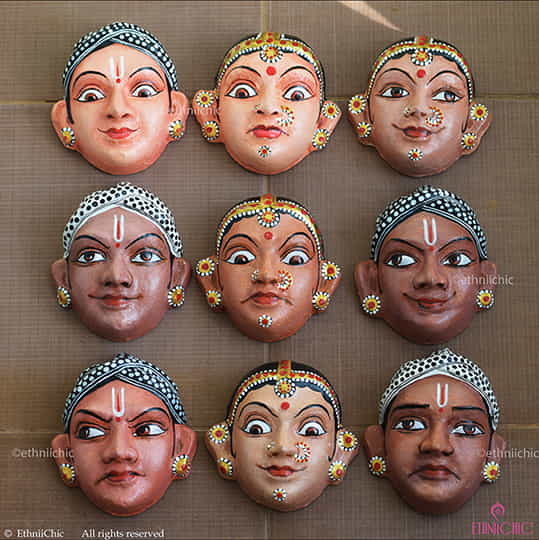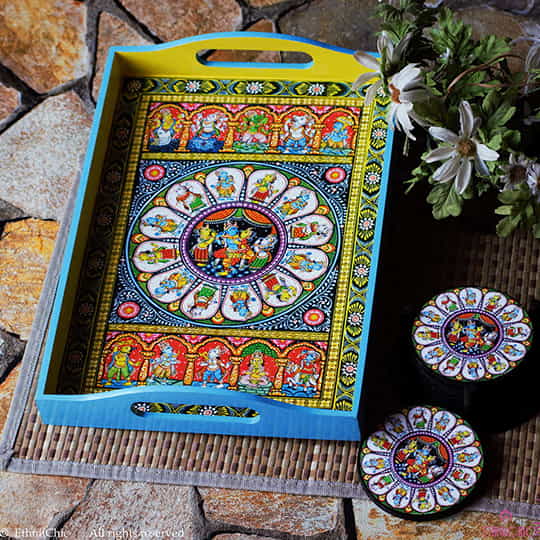Kerala, often called ‘God’s Own Country,’ is renowned for its vibrant traditions, scenic landscapes, and rich artistic heritage. Among its many artistic expressions, Kerala mural art stands out as a magnificent form of storytelling that blends intricate detailing with profound symbolism. Rooted in ancient Hindu traditions and deeply inspired by religious themes, these murals serve as visual poetry, conveying complex spiritual and cultural narratives.
For art enthusiasts, Kerala mural art is not just about appreciating the vivid colors and elaborate designs but also about delving into the deeper symbolism that each motif, hue, and expression embodies. In this blog, we embark on a journey to decode the symbolic essence of Kerala murals, providing insight into their significance and cultural impact.
The Historical and Cultural Roots of Kerala Mural Art
Kerala mural art traces its origins back to the 8th century, flourishing primarily during the medieval period under the patronage of various Hindu rulers. The art form is deeply rooted in temple traditions, adorning the walls of sacred spaces like Padmanabhaswamy Temple, Guruvayur Temple, and Ettumanoor Mahadeva Temple. These murals, painted using natural pigments derived from minerals and plants, follow a specific set of aesthetic principles known as the ‘Shilpa Sastra.’
While the themes of these murals predominantly revolve around Indian mythology, epics like the Ramayana and Mahabharata, and various Puranic legends, they also depict elements of nature, celestial beings, and philosophical concepts. The murals serve as visual scriptures, offering devotees a meditative experience as they immerse themselves in the intricate depictions of deities and divine events.
Symbolic Representation of Colors
One of the most striking features of Kerala mural art is its use of a distinctive color palette, with each hue holding deep symbolic meaning. The traditional five-color scheme used in these murals includes:
- Red – Represents vigor, passion, and divine energy. It is often used for characters like Hanuman or forms of Devi (Goddess) that embody power and ferocity.
- Yellow (Ochre) – Signifies purity, wisdom, and divinity. It is commonly seen in depictions of Lord Vishnu and other benevolent deities.
- Green – Symbolizes prosperity, fertility, and tranquility, often associated with nature and characters like Lord Krishna.
- Blue – Represents cosmic consciousness, infinity, and divinity. Lord Shiva and Lord Vishnu are often depicted in shades of blue, indicating their boundless power and omnipresence.
- White – Denotes peace, enlightenment, and spiritual liberation. Saints, sages, and divine beings with serene auras are illustrated in white tones.
Understanding the meaning of colors enhances one’s appreciation of the emotional and spiritual depth encapsulated in these murals.
Each deity is carefully depicted using colors that align with their mythological and spiritual attributes. For example, Lord Vishnu is often painted blue, signifying his boundless cosmic presence, whereas Goddess Saraswati is rendered in white, denoting knowledge and serenity.
The Iconography of Divine Figures
Kerala mural art meticulously adheres to iconographic conventions that dictate how divine figures should be represented. Each deity is characterized by specific attributes, postures, and gestures that convey their unique essence. Some notable examples include:
- Lord Vishnu – Often depicted with four arms holding a conch (shankha), discus (chakra), mace (gada), and lotus (padma), each signifying aspects of cosmic order and protection.
- Lord Shiva – Portrayed with matted hair, the crescent moon, and the third eye, symbolizing destruction and regeneration.
- Goddess Durga – Shown riding a lion or tiger, wielding multiple weapons, and embodying the power to annihilate evil.
- Lord Krishna – Frequently illustrated playing the flute, symbolizing divine love and the eternal connection between the soul and the Supreme.
Each of these figures is placed within intricate backgrounds, often featuring celestial beings, sacred flora, and intricate patterns that enhance the narrative’s spiritual depth.
The Role of Mudras (Hand Gestures)
Much like classical Indian dance forms, Kerala murals use mudras, or symbolic hand gestures, to communicate emotions and philosophical concepts. Some commonly found mudras include:
- Abhaya Mudra (Gesture of Fearlessness) – A raised right hand with the palm facing outward, conveying protection and reassurance.
- Varada Mudra (Gesture of Boon-Giving) – A downward-facing open palm, symbolizing generosity and blessings.
- Dhyana Mudra (Meditative Gesture) – Hands resting on the lap with the fingers touching, representing deep contemplation and spiritual wisdom.
- Anjali Mudra (Gesture of Salutation) – Hands joined together in a prayerful pose, symbolizing reverence and devotion.
By decoding these gestures, art lovers can gain a richer understanding of the messages and emotions embedded in the murals.
The Narrative Composition and Storytelling Techniques
Kerala murals employ a unique narrative style, often following a pictorial storytelling approach where multiple scenes unfold within a single frame. This allows for a seamless representation of divine stories, much like a visual manuscript. Some notable storytelling techniques include:
- Continuous Narrative Style – Different episodes of a story are depicted within the same frame, creating a fluid visual journey.
- Hierarchical Proportions – Divine figures are often painted larger than human characters, symbolizing their supreme status.
- Ornamental Detailing – Exquisite borders, floral motifs, and geometric patterns add layers of depth and aesthetics to the murals.
These artistic conventions elevate Kerala murals from mere decorations to profound visual epics.
Nature and Its Sacred Symbolism
Kerala murals integrate elements of nature with deep symbolic meaning. Some common motifs include:
- Lotus Flower: A recurring motif symbolizing purity, enlightenment, and spiritual awakening.
- Peacocks: Representing beauty, grace, and divine protection, peacocks are often depicted alongside Lord Murugan.
- Elephants: A symbol of wisdom, prosperity, and strength, frequently seen in temple murals.
- Serpents: Indicative of cosmic energy (Kundalini) and the cycle of life and rebirth.
The integration of nature in mural art highlights the intrinsic connection between the divine and the natural world.
The Spiritual and Meditative Experience
Beyond their artistic and aesthetic appeal, Kerala murals serve as spiritual conduits, facilitating meditation and devotion. The detailed compositions, vibrant colors, and symbolic representations create an environment that fosters inner reflection and a deeper connection with the divine.
For centuries, temple visitors have engaged with these murals not just as spectators but as seekers of wisdom and spiritual enlightenment. The very act of observing these paintings can be likened to an immersive, meditative experience, where the observer absorbs the divine essence of the depicted deities and their cosmic narratives.
Symbolic Storytelling through Composition
The composition of Kerala murals follows a structured hierarchy that conveys deeper meanings. Murals in temples often feature larger-than-life deities at the center, surrounded by smaller celestial beings and devotees, symbolizing the divine order of the universe. The background elements, such as clouds, celestial chariots, and floral patterns, create a cosmic ambiance, reinforcing the transcendental nature of the subject.
For example, the Ananthasayana mural in the Padmanabhaswamy Temple depicts Lord Vishnu in a reclining posture on the serpent Ananta, with deities and sages surrounding him in awe. This composition conveys the concept of eternal preservation and cosmic harmony.
Preserving Kerala Mural Art
Despite its grandeur and historical significance, Kerala mural art faces challenges in terms of preservation. The traditional methods of using natural pigments, lime-plastered walls, and time-intensive craftsmanship are under threat due to modernization and changing artistic preferences. However, concerted efforts are being made to revive and sustain this heritage through:
- Training Programs – Institutions like The Guruvayur Devaswom’s Institute of Mural Painting and various art schools are dedicated to teaching the traditional techniques of mural painting.
- Digital Archiving – Several organizations are working to digitally document Kerala murals, ensuring their accessibility to future generations.
- Restoration Projects – Many temples and heritage sites are undergoing conservation efforts to protect and restore the aging murals.
Art enthusiasts can contribute to this preservation by supporting local mural artists, attending workshops, and spreading awareness about this extraordinary art form.
Contemporary Relevance of Kerala Mural Art
With the renewed interest in traditional art forms, Kerala mural art is experiencing a revival in modern aesthetics. Artists now incorporate mural motifs into:
- Interior design: Homes and hotels feature murals on walls and furniture.
- Fashion: Sarees, kurtas, and jewelry are adorned with mural-inspired designs.
- Digital Art: Artists recreate mural themes using digital media, making them accessible worldwide.
Additionally, several art institutions in Kerala offer training programs in mural painting, preserving the legacy for future generations.
EthniiChic has consistently excelled in presenting this vibrant art form to the world in its most exquisite expression, in the form of canvas paintings for Wall Decor, Hand painted jewelry, Hand painted multi functional decor / utility products
Conclusion: A Timeless Legacy
Kerala mural art is more than just an aesthetic marvel; it is a bridge between the past and present, carrying forward the legacy of India’s rich artistic and spiritual traditions. For those who take the time to explore its symbolism, each painting becomes a gateway to a deeper understanding of mythology, philosophy, and cultural ethos.
As art lovers, immersing ourselves in Kerala murals allows us to witness the profound synergy between artistry and devotion, where every brushstroke tells a story, and every color whispers an ancient truth. Whether as a traveler visiting the temples of Kerala or as a connoisseur studying this exquisite art form, embracing its symbolism offers an enriching and transformative experience.
So next time you stand before a Kerala mural, take a moment to go beyond the surface—to decode its colors, read its gestures, and immerse yourself in the sacred narrative it seeks to share. In doing so, you will not just be looking at a painting; you will be stepping into a world where art and divinity become one.


